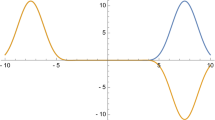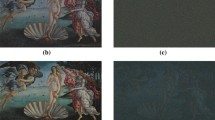Abstract
In this paper, we consider the question of finding an as small as possible family of operators \((T_j)_{j\in J}\) on \(L^2({\mathbb {R}})\) that does phase retrieval: every \(\varphi \) is uniquely determined (up to a constant phase factor) by the phaseless data \((|T_j\varphi |)_{j\in J}\). This problem arises in various fields of applied sciences where usually the operators obey further restrictions. Of particular interest here are so-called coded diffraction patterns where the operators are of the form \(T_j\varphi ={\mathcal F}[m_j\varphi ]\), \({\mathcal F}\) the Fourier transform and \(m_j\in L^\infty ({\mathbb {R}})\) are “masks”. Here we explicitly construct three real-valued masks \(m_1,m_2,m_3\in L^\infty ({\mathbb {R}})\) so that the associated coded diffraction patterns do phase retrieval. This implies that the three self-adjoint operators \(T_j\varphi ={\mathcal F}[m_j{\mathcal F}^{-1}\varphi ]\) also do phase retrieval. The proof uses complex analysis. We then show that some natural analogs of these operators in the finite dimensional setting do not always lead to the same uniqueness result due to an under-sampling effect.
Similar content being viewed by others
Data Availability
No data has been generated or analyzed during this study.
Notes
Note that we normalized the Fourier transform \({\mathcal F}\) so that it is unitary. Its adjoint is thus the inverse Fourier transform \({\mathcal F}^*\varphi (x)={\mathcal F}^{-1}\varphi (x)={\mathcal F}\varphi (-x)\).
References
Akutowicz, E.: On the determination of the phase of a Fourier integral. I. Trans. Amer. Math. Soc. 83, 179–192 (1956)
Balan, R., Casazza, P., Edidin, D.: On signal reconstruction without phase. Appl. Comp. Harmon. Anal. 20, 345–356 (2006)
T. Bendory, R. Beinert & Y. C. Eldar, Fourier phase retrieval: uniqueness and algorithms. In Compressed sensing and its applications, Appl. Numer. Harmon. Anal., pages 55–91. Birkhäuser/Springer, Cham, 2017
Bodmann, B.G., Hammen, N.: Stable phase retrieval with low-redundancy frames. Adv. Comput. Math. 41, 317–331 (2015)
Busch, P., Lahti, P.J.: The determination of the past and the future of a physical system in quantum mechanics. Found. Phys. 19, 633–78 (1989)
Candès, E., Li, X., Soltanolkotabi, M.: Phase retrieval from coded diffraction patterns. Appl. Comput. Harmon. Anal. 39, 277–299 (2015)
Candès, E.J., Eldar, Y., Strohmer, T., Voroninski, V.: Phase retrieval via matrix completion. SIAM Review 57, 225–251 (2015)
Conca, A., Edidin, D., Hering, M., Vinzant, C.: An algebraic characterization of injectivity in phase retrieval. Appl. Comp. Harmon. Anal. 38, 346–356 (2015)
Corbett, J.V.: The Pauli problem, state reconstruction and quantum-real numbers. Rep. Math. Phys. 57, 53–68 (2006)
Corbett, J.V., Hurst, C.A.: Are wave functions uniquely determined by their position and momentum distributions? J. Austral. Math. Soc B 20, 182–201 (1978)
Fickus, M., Mixon, D.G., Nelson, A.A., Wang, Y.: Phase retrieval from very few measurements. Linear Algebra Appl. 449, 475–499 (2014)
Goodman, J.: Introduction to Fourier optics. Freeman, McGraw-Hill physical and quantum electronics series. W. H (2005)
Goyeneche, D., Catas, G., Etcheverry, S., Gómez, E.S., Xavier, G.B., Lima, G., Delgado, A.: Five measurement bases determine pure quantum states on any dimension. Phys. Rev. Lett. 115, 090401 (2015)
Grohs, P., Rathmair, M.: Stable Gabor phase retrieval and spectral clustering. Comm. Pure Appl. Math. 72, 981–1043 (2019)
Grohs, P., Koppensteiner, S., Rathmair, M.: Phase retrieval: uniqueness and stability. SIAM Review 62, 301–350 (2020)
Gross, D., Krahmer, F., Kueng, R.: Improved recovery guarantees for phase retrieval from coded diffraction patterns. Appl. Comput. Harmon. Anal. 42, 37–64 (2017)
Hofstetter, E.: Construction of time-limited functions with specified autocorrelation functions. IEEE Trans. Inform. Theory 10, 119–126 (1964)
Heinosaari, T., Mazzarella, L., Wolf, M.M.: Quantum tomography under prior information. Commun. Math. Phys. 318, 355–374 (2013)
Ismagilov, R.S.: On the Pauli problem. Funksional Anal i Prilozhen 30, 82–84 (1996)
K. Jaganathan, Y. C. Eldar & B. Hassibi, Phase retrieval: an overview of recent developments. In Optical compressive imaging, Ser. Opt. Optoelectron., pp 263-296. CRC Press, Boca Raton, FL (2017)
Jaming, Ph.: Phase retrieval techniques for radar ambiguity functions. J. Fourier Anal. Appl. 5, 313–333 (1999)
Jaming, Ph.: Uniqueness results in an extension of Pauli’s phase retrieval problem. Applied and Comp. Harm. Anal. 37, 413–441 (2014)
Jaming, Ph., Kellay, K., Perez III, R.: Phase retrieval for wide band signals. J. Fourier Anal. Appl. 26(54) (2020)
Janssen, A.J.E.M.: The Zak transform and some counterexamples in time-frequency analysis. IEEE Trans. Inform. Theory 38, 168–171 (1992)
Klibanov, M.V., Sacks, P.E., Tikhonravov, A.V.: The phase retrieval problem. Inverse Problems 11 (1995)
Mondragon, D., Voroninski, V.: Determination of all pure quantum states from a minimal number of observables. arXiv:1306.1214
Mc Donald, J.: Phase retrieval and magnitude retrieval of entire functions. J. Fourier Anal. Appl. 10, 259–267 (2004)
D. G. Mixon, Phase Transitions in phase retrieval. In: Balan R., Begué M., Benedetto J., Czaja W., Okoudjou K. (eds) Excursions in Harmonic Analysis, Volume 4. Applied and Numerical Harmonic Analysis. Birkhäuser (2015)
Morov, B.Z., Perelomov, A.M.: On a problem posed by Pauli. Theor. Math. Phys. 101, 1200–1204 (1994)
Pauli, W.: Die allgemeinen Prinzipien der Wellenmechanik. In: Geiger, H., Scheel, K. (eds.) Handbuch der Physik, vol. 24, pp. 83-272. Springer-Verlag, Berlin (1933) English translation: General Principles of Quantum Mechanics, Springer-Verlag, Berlin, 1980
Reichenbach, H.: Philosophic foundations of quantum mechanics. Univesity of California Press, Berkeley (1944)
Vinzant, C.: A small frame and a certificate of its injectivity. Sampling Theory and Applications (SampTA) Conference Proceedings, pp. 197–200. (2015)
Vogt, A.: Position and momentum distributions do not determine the quantum mechanical state. In: Marlow, A.R. (ed.) Mathematical Foundations of Quantum Theory. Academic Press, New York (1978)
Shechtman, Y., Eldar, Y.C., Cohen, O., Chapman, H., Miao, J., Segev, M.: Phase retrieval with application to optical imaging: a contemporary overview. 32, 87–109 (2015)
Walther, A.: The question of phase retrieval in optics. Optica Acta 10, 41–49 (1963)
Funding
The second author was supported by an Erwin-Schrödinger Fellowship (J-4523) of the Austrian Science Fund FWF.
Author information
Authors and Affiliations
Contributions
The authors wish to thank the anonymous referees for the constructive remarks that lead to an improvement of the presentation of the results.
Corresponding author
Ethics declarations
Conflicts of interest
The authors have no relevant financial or non-financial interests to disclose.
Additional information
Communicated by: Gitta Kutyniok
Publisher's Note
Springer Nature remains neutral with regard to jurisdictional claims in published maps and institutional affiliations.
Appendix
Appendix
The purpose of this section is to provide some background on Wright’s conjecture, as formulated in Conjecture 1.1.
We begin with introducing the main objects and notions appearing in quantum mechanics that we need here. The space of all possible states of a quantum mechanical system is represented by \(L^2(\mathbb {R})\). A state \(\psi \in L^2(\mathbb {R})\) is also called a wave function. Two wave functions \(\psi \) and \(\varphi \) are considered equivalent if they agree up to multiplication by a unimodular constant.
Quantities of a system that can be measured are called observables and represented by densely-defined self-adjoint operators on \(L^2(\mathbb {R})\). The expected value of the state \(\psi \in D(A)\) in the observable A is defined as
The two following examples are essential in this paper. Let \(u,v\in L^\infty ({\mathbb {R}})\) be real valued. To u and v associate the following two observablesFootnote 1
Then
and
Here, we keep the convention of notation in mathematics where the position variable is denoted by x and the momentum variable is denoted by \(\xi \) instead of p.
Let \({\mathcal B}\) be the set of Borel subsets of \({\mathbb {R}}\). It is then obvious that \(|\psi (x)|\) is uniquely determined by
which is called the distribution of the state \(\psi \) with respect to position since
where \(\textbf{1}_B(Q)\) are the spectral projections associated to the position operator.
On the other hand \(|\widehat{\psi }(\xi )|\) is uniquely determined by distribution of the state \(\psi \) with respect to momentum:
where \(\textbf{1}_B(P)\) are the spectral projections associated to the momentum operator.
In a footnote to the Handbuch der Physik article on the general principle of wave mechanics [30], W. Pauli asked whether a wave function \(\psi \) is uniquely determined (up to a constant phase factor) by one of the equivalent quantities
-
the Pauli data \((|\psi |,|\widehat{\psi }|)\);
-
\(\big \{\Vert \textbf{1}_B(Q)\psi \Vert \big \}_{B\in {\mathcal B}}\), \(\big \{\Vert \textbf{1}_B(P)\psi \Vert \big \}_{B\in {\mathcal B}}\);
-
\(\big \{E_\psi (M_{\textbf{1}_B})\big \}_{B\in {\mathcal B}}\), \(\big \{E_\psi ({\mathcal M}_{\textbf{1}_B})\big \}_{B\in {\mathcal B}}\).
The question can also be found e.g. in the book by H. Reichenbach [31] and in Busch & Lahti [5].
As mentioned in the introduction, it is known that in general the Pauli data does not uniquely determine the state \(\psi \) (up to a constant phase factor).
It is then natural to ask whether there exists a set of observables \((A_j)_{j\in J}\) (preferably including position and momentum or at least having a physical meaning) such that the associated sets built from spectral projections
uniquely determine every state \(\psi \).
Using the spectral theorem, to a self-adjoint operator \(A_j\) we can associate a unitary operator \(U_j\) and a multiplication operator \(M_j\) on a space \(L^2(\mu _j)\) such that \(A_j=U_j^*M_jU_j\). Then the data \(\mathcal {E}_j\), \(j\in J\) uniquely determine \(|U_j\psi |\), \(j\in J\). This then directly leads to Wright’s Conjecture 1.1 and to its relaxation 1.2: find a set of measures \(\mu _j\) and unitary operators \(U_j:L^2({\mathbb {R}}^d)\rightarrow L^2(\mu _j)\) such that \(|U_j\psi |=|U_j\varphi |\), \(j\in J\), implies that \(\psi \) and \(\varphi \) are equivalent up to a constant phase factor.
A relaxed version is to find a set \(\{T_j\}_{j\in J}\) of bounded self-adjoint (or even only bounded) operators on \(L^2({\mathbb {R}})\) such that \(|T_j\psi |=|T_j\varphi |\), \(j\in J\), implies that \(\psi \) and \(\varphi \) are equivalent up to a constant phase factor. The data \(|T_j\psi |\) can also be interpreted as an expectation of the state \(\psi \) with respect to a family of observables. To be more precise, to a bounded operator T, we may associate the self-adjoint operator \(A_u=T^*M_uT\) with \(u\in L^\infty ({\mathbb {R}})\) real valued. Then
so that \(|T\psi |\) is uniquely determined by
However, it does not seem possible to reformulate this family of measurements in terms of spectral projections associated to a single self-adjoint operator.
Rights and permissions
Springer Nature or its licensor (e.g. a society or other partner) holds exclusive rights to this article under a publishing agreement with the author(s) or other rightsholder(s); author self-archiving of the accepted manuscript version of this article is solely governed by the terms of such publishing agreement and applicable law.
About this article
Cite this article
Jaming, P., Rathmair, M. Uniqueness of phase retrieval from three measurements. Adv Comput Math 49, 47 (2023). https://doi.org/10.1007/s10444-023-10045-z
Received:
Accepted:
Published:
DOI: https://doi.org/10.1007/s10444-023-10045-z




